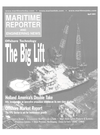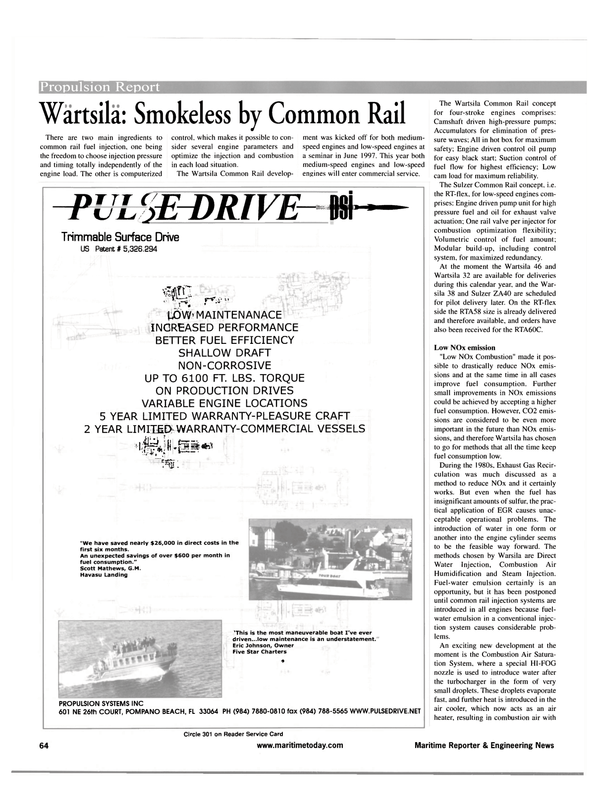
Wartsila: Smokeless by Common Rail
There are two main ingredients to common rail fuel injection, one being the freedom to choose injection pressure and timing totally independently of the engine load. The other is computerized control, which makes it possible to consider several engine parameters and optimize the injection and combustion in each load situation.
The Wartsila Common Rail development was kicked off for both mediumspeed engines and low-speed engines at a seminar in June 1997. This year both medium-speed engines and low-speed engines will enter commercial service.
The Wartsila Common Rail concept for four-stroke engines comprises: Camshaft driven high-pressure pumps; Accumulators for elimination of pressure waves; All in hot box for maximum safety: Engine driven control oil pump for easy black start; Suction control of fuel flow for highest efficiency; Low cam load for maximum reliability.
The Sulzer Common Rail concept, i.e.
the RT-flex, for low-speed engines comprises: Engine driven pump unit for high pressure fuel and oil for exhaust valve actuation; One rail valve per injector for combustion optimization flexibility; Volumetric control of fuel amount; Modular build-up, including control system, for maximized redundancy.
At the moment the Wartsila 46 and Wartsila 32 are available for deliveries during this calendar year, and the Warsila 38 and Sulzer ZA40 are scheduled for pilot delivery later. On the RT-flex side the RTA58 size is already delivered and therefore available, and orders have also been received for the RTA60C.
Low NOx emission "Low NOx Combustion" made it possible to drastically reduce NOx emissions and at the same time in all cases improve fuel consumption. Further small improvements in NOx emissions could be achieved by accepting a higher fuel consumption. However, C 0 2 emissions are considered to be even more important in the future than NOx emissions, and therefore Wartsila has chosen to go for methods that all the time keep fuel consumption low.
During the 1980s, Exhaust Gas Recirculation was much discussed as a method to reduce NOx and it certainly works. But even when the fuel has insignificant amounts of sulfur, the practical application of EGR causes unacceptable operational problems. The introduction of water in one form or another into the engine cylinder seems to be the feasible way forward. The methods chosen by Warsila are Direct Water Injection, Combustion Air Humidification and Steam Injection.
Fuel-water emulsion certainly is an opportunity, but it has been postponed until common rail injection systems are introduced in all engines because fuelwater emulsion in a conventional injection system causes considerable problems.
An exciting new development at the moment is the Combustion Air Saturation System, where a special HI-FOG nozzle is used to introduce water after the turbocharger in the form of very small droplets. These droplets evaporate fast, and further heat is introduced in the air cooler, which now acts as an air heater, resulting in combustion air with about 60 g humidity per kg air. With this amount of water it is possible to arrive at NOx levels of 3 g/kWh. The HI-FOG nozzles and the water technology are provided by Marioff. For low-speed engines the Water Cooled Rest Gas (WaCoReG) is pursued. This system utilizes the same mechanism as an EGR system would, i.e. introducing some rest gas into the combustion space.
Fuel flexibility Wartsila has given priority to the development of engines capable of operating on Orimulsion and even bottom oils. One logic is that these fuels are so cheap that it is possible to apply a considerable amount of exhaust gas cleaning technologies and still deliver energy at a cost-effective price. Geologists and chemists seem to agree that the large salt water seas have unlimited capacity to take sulfur emissions. The trick seems to be to get the emissions to touch the salt water before they touch sensitive vegetation on land. Sea water scrubbing sounds like an interesting opportunity if such a device could be made to work. For this reason Wartsila has taken up the development of a scrubber system together with Marioff.
Minimized waste Increased efforts on numerous fronts have been designed to minimize diesel engine wastes, including used lubricating oil, used oil filter cartridges, and spare parts scrap. The way to avoid used lubricating oil is never to have to change the oil. That was quite easy in the past when oil consumption was high. With the introduction of the antipolishing ring the threshold became higher. However, the oil companies have responded well to the challenge, and at the moment an oil consumption of 0.4 g/kWh is enough for the best lubricating oils to keep them stable without oil changes. Development is going on all the time.
Read Wartsila: Smokeless by Common Rail in Pdf, Flash or Html5 edition of April 2001 Maritime Reporter
Other stories from April 2001 issue
Content
- The New Knowledge Brokers? page: 8
- Crowley Launches Refurbishment Of 25 Seagoing Tugs page: 9
- Boat-Park.com — The Virtual Trade Show That Never Sleeps page: 12
- LevelSeas Buys SeaLogistics page: 12
- Proposed Regulations Regarding Source of Income From Activities In Intl. Waters page: 14
- COMSAT Mobile Communications Working With U.S. Coast Guard To Save Lives At Sea page: 18
- ASNE Day 2001 To Feature Timely Technical Papers, Informative Exhibits page: 20
- Adsteam To Buy Howard Smith page: 22
- Bollinger To Construct Pair of Vessels For Seacor Marine page: 24
- Holland America's New Ship Points Toward New Visa page: 25
- Cruise + Ferry 2001 Preview page: 25
- Radiance of the Seas — A First Class Delivery page: 26
- Cruise Lines Equip Fleets With Emergency Smoke Hoods page: 27
- Blount Retires From ACCL; Names Daughter As Successor page: 28
- Help Protect Interiors With SS Sanparrel page: 31
- The FPU Market Is Primed To Produce page: 33
- CWWS Delivers 200 Separators To Tidewater page: 38
- A Leg Up on the Competition page: 40
- Seacor Continues Rational Fleet Expansion page: 44
- GLM Poised For A Strong 2001 page: 46
- Friede Goldman Halter Negotiates $100M Financing page: 48
- Clamp Supplier Dives Into Project page: 49
- Dockwise Performs Timely Delivery Of Shell's Brutus page: 50
- Bollinger Wins K-Sea DH Barge Contract page: 52
- Telenor To Acquire COMSAT page: 52
- First Order For Dolphin Propulsion System page: 54
- Stena Discovery Performance Improved With Enhanced Steering System page: 54
- Voith Adds To Its Innovative Range page: 58
- Wartsila: Smokeless by Common Rail page: 64
- Wartsila, Marioff To Cooperate On Emission Control Technolgy page: 65
- Technology, Image Top Inland Agenda page: 66
- Leading Societies Launch Sweeping Safety Initiatives page: 73
- IZAR Delivers For Stena page: 74
- Furuno's New NavNet Is Compact, Seamless page: 74
- Finland: Cradle of Marine High-Tech page: 75


